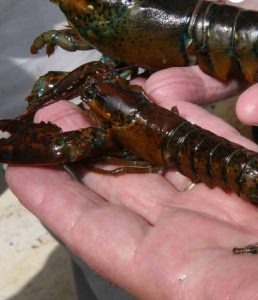Life Cycle & Reproduction
 Female lobster:
Female lobster:
A female lobster mates primarily when she is in the soft-shell state,
right after she has shed her shell (molted). The photo to the left shows
an egg-bearing lobster, also known as a “berried” lobster.
Eggs:
A freshly laid lobster egg is the size of the head of a pin (1/16″). A 1-pound female lobster usually carries approximately 8,000 eggs. A 9-pound female may carry more than 100,000 eggs. The female lobster carries the eggs inside for 9 to 12 months and then for another 9 to 12 months, externally attached to the swimmerets under her tail by a glue-like substance. When the eggs hatch, the mother releases them by fanning her swimmerets.
Larval Sta ge:
ge:
Now in the first larval stage, the newborn lobsters will float near the surface for 4 to 6 weeks. They are very susceptible to prey during this stage and will go through three molts or stages.
Post-Larval Stage:
After the fourth molt the few that survive will settle to the bottom; look for hiding places in rocks, grassy areas, etc. and continue to develop as post-larval lobsters. For every 50,000 eggs, only about two lobsters are expected to survive to legal size.
Juvenile Lobsters :
:
As the lobsters grow, they become more adventuresome and hide less. Their habits are similar to adult lobsters. It takes 5 to 7 years for a lobster to grow to the legal size to harvest. A lobster at minimum legal size will weigh approximately 1 pound. (Based on Maine’s legal minimum of 3 1/4″ carapace size. Legal sizes can vary by state/country.) Juvenile lobsters can molt as many as 25 times before reaching adulthood. See the photo of juvenile lobsters on the right.
Adult Lobsters:
Lobsters reach adulthood after 5-8 years. As adults, males typically shed or molt once a year, and females once every two years.
Molting:
Lobsters grow by molting. This is the process in which they struggle out of their old shells while simultaneously absorbing water, which expands their body size. After molting, lobsters will eat voraciously, often devouring the shells they just shed. This replenishes lost calcium and hastens the hardening of the new shell.
Click for links to molting photos and videos.
This molting, or shedding, occurs about 25 times in the first 5-7 years of life. Following this cycle, the lobster will weigh approximately one pound. After this time, the lobster may then only molt once per year (males) or once every two years (females). At this point, with each molt, the lobster will increase about 15% in length and 40% in weight. No one has yet found a way to determine the exact age of a lobster. However, based on scientific knowledge of body size at age, the maximum age attained may approach 100 years. Lobsters can grow to be 3 feet or more in overall body length.
We recommend the following links for more detailed information about the lifecycle & reproduction of the American lobster:
